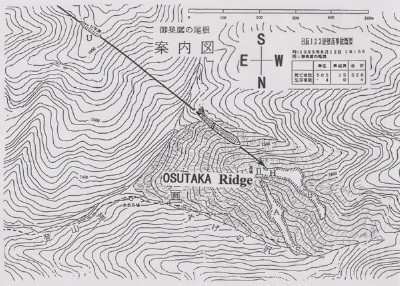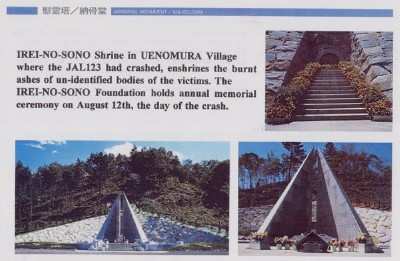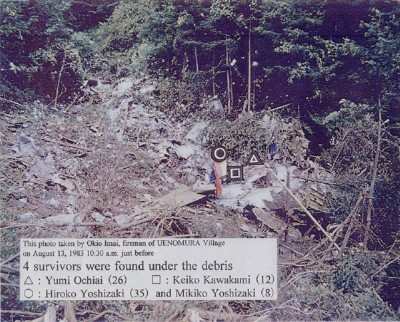Anniversary of JAL 123 Mourned By Relatives, Airline Execs
by Aero-News Senior Correspondent Kevin R.C. "Hognose"
O'Brien
 America is often accused of having a
culture hostile to ideas of personal responsibility: self-help
books, slip-and-fall lawyers, 12-step recovery cults, you name it,
that's us. Excuses, excuses, excuses. The converse is often said of
Japan: a corporate screw-up that produces stonewalling and
indignant, legalistic defiance in the States would instead produce
a teary confession and letter of resignation.
America is often accused of having a
culture hostile to ideas of personal responsibility: self-help
books, slip-and-fall lawyers, 12-step recovery cults, you name it,
that's us. Excuses, excuses, excuses. The converse is often said of
Japan: a corporate screw-up that produces stonewalling and
indignant, legalistic defiance in the States would instead produce
a teary confession and letter of resignation.
So it's probably only in Japan that an airline executive would
mark the 20th anniversary of his airline's blackest day by climbing
the steep, rugged mountains to the spot where 520 souls that
trusted his airline died, victims of a tragic maintenance
error.
Toshiyuki Shimmachi, JAL's President, joined other mourners on
an anniversary climb to Osutaka Ridge in Gunma Prefecture, north
and west of Tokyo, on August 12th. At the top, he laid flowers and
uttered an impassioned pledge to the souls of the dead, that he
would not permit such a disaster to happen again.

JAL 123 remains a case study in aviation safety courses, and it
hovers in the backs of maintenance chiefs' minds, a nightmare
waiting to strike. The flight was a routine hop from Tokyo to Osaka
when the aft pressure bulkhead blew out; the escaping high-pressure
air from the cabin slammed into the vertical stabilizer, which was
never built to take pressurization loads from inside.
The vertical stab blew away, leaving enough of a stub to prevent
the airplane from tumbling immediately, but not enough to provide
positive control. The quadruply-redundant hydraulic systems, all
four compromised by the failure, quickly vented their vital fluid
overboard.
The pilots were left with only engines for control. Al Haynes
and Denny Fitch had pulled it off, sort of, in United 232; but that
plane was a trijet where the different thrustlines of the wing and
center engines could help out with pitch. JAL 123 was a Boeing
747SR with all its engines under the wings.
"Uncontrol, uncontrol!" the captain reported to enroute traffic
control. And despite the flight crew's valiant efforts, and the
anxious attempts of ATC to help, the plane hit the side of Osutaka
Ridge. The controller at Tokyo watched in horror as the plane's
Mode C data block read 8400 feet, an altitude he knew was lower
than the terrain, and then went into coast mode.

A Japanese military plane reported to its base "a huge burst of
flame in the Nagano mountains." It was the pyre of Flight 123.
Three passengers and one deadheading off-duty stewardess, found
underneath the wreckage by Japanese Ground Self Defense Force
rescue crews, were the only survivors. 520 others perished in the
worst single-plane disaster, ever. (Japanese domestic flights often
carry such large numbers. The B-747SR was made for this
high-density, short-haul market and seats up to 550 pax and 12
cabin crew; JAL's SRs were configured for 528 pax).
The investigation revealed, though, that JA-8119, the 747SR
airframe involved in the crash, had a history. On June 2, 1978, it
suffered a violent tail strike which failed, among other parts of
the fuselage, the aft pressure bulkhead. The aircraft was repaired
by JAL and Boeing mechanics, under the supervision of Boeing
engineers.
And they got it wrong. Instead of overlapping a doubler to
strengthen the damaged craft, they had divided the doubler into the
two pieces, butt-jointed together along the line of the repair. No
overlap. Where the original design had three layers of metal joined
by multiple rows of rivets, in fact, now, the pressurization loads
were borne by a single sheet of metal, joined on each side to the
other pieces by only one row of rivets each. The plain was signed
off for return to service.

It was a recipe for trouble. The repair lasted for seven years,
and thousands of cycles (the machine had 18,830 cycles on it in
25,025 hours). The bulkhead was inspected on no less than six
C-Checks (done at 3,000 hour intervals) between the repair and the
mishap, and no anomalies were noted. But each cycle was loading the
same single row of rivets in shear and tension, and flexing that
same single sheet of metal. Failure was inevitable. And when -- not
if -- the bulkhead failed, the path of least resistance for the
overpressure was into the vertical stab, which was never imagined
as a pressure vessel.
JAL, the Japanese corporation, accepted the blame for the
mishap. Boeing, the American corporation, fought, but ultimately
settled claims of some of the victims of Flight 123.
Every Boeing 747 was inspected, with special attention to ones
that had seen hard landings or repairs, or that had high cycles or
hours. Boeing designed a change to the tail that allowed internal
overpressure to blow out a sacrificial panel, and the world's
aviation authorities made it a mandatory AD. The company reviewed
and, where necessary, changed, C-check and heavy airframe
maintenance procedures.

But JAL's acceptance came in what seems to a Westerner to be
uniquely Japanese ways. In the immediate aftermath of the crash,
JAL rushed employees, 1,000 of them, to the remote site, to assist
in search and rescue efforts. At least one member of the airline's
board of directors attended every crew and passenger funeral -- all
520 of them. And a maintenance supervisor at Tokyo's Haneda Airport
wrote out a note of apology -- and killed himself.
JAL's then-president, Mr Yasumoto Takagi, tendered his
resignation to Prime Minister Yasuhiro Nakasone. Nakasone accepted
the resignation.
Since the accident, a memorial has been constructed on Osutaka
Ridge, which is just about as remote and as difficult to get to as
it was for the rescuers in 1985. And on the anniversary of the
accident -- August 12th -- survivors of the victims, hundreds of
them, climb the hill to the memorial. Some pray, some cry, some
light candles.
And the president of the company stands with wet eyes and speaks
of his company's blackest day, and makes a pledge: never again.
 ANN's Daily Aero-Linx (04.13.24)
ANN's Daily Aero-Linx (04.13.24) ANN's Daily Aero-Term (04.13.24): Beyond Visual Line Of Sight (BVLOS)
ANN's Daily Aero-Term (04.13.24): Beyond Visual Line Of Sight (BVLOS) Airborne 04.09.24: SnF24!, Piper-DeltaHawk!, Fisher Update, Junkers
Airborne 04.09.24: SnF24!, Piper-DeltaHawk!, Fisher Update, Junkers Aero-News: Quote of the Day (04.14.24)
Aero-News: Quote of the Day (04.14.24) ANN's Daily Aero-Term (04.14.24): Maximum Authorized Altitude
ANN's Daily Aero-Term (04.14.24): Maximum Authorized Altitude






